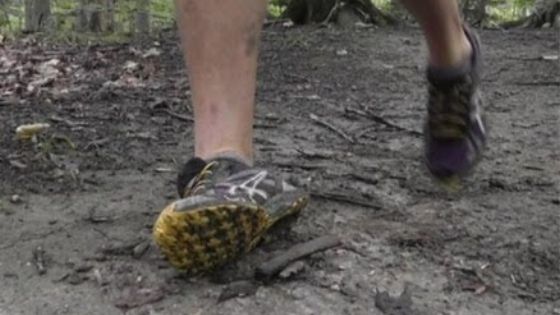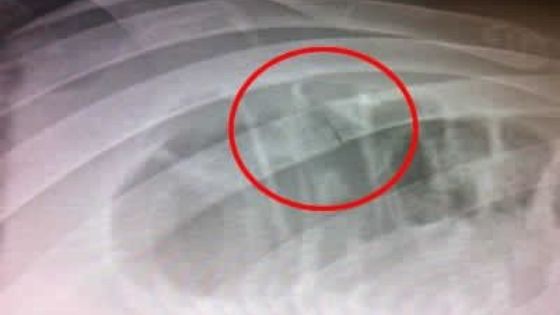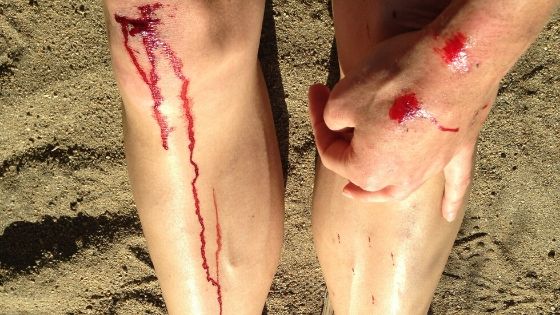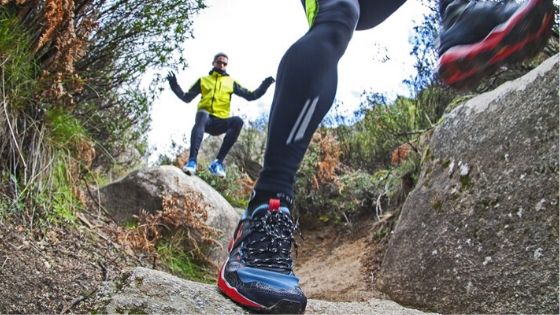
Six years ago my friend Robyn managed to qualify for the Ironman World Championship in Kona after five years of trying. When she returned we got together for coffee. Robyn described to me the anxiety and fear that she and most of the other athletes felt during the week leading up to the big race.
She and other athletes had spent and sacrificed massive massive amounts just to get to the Big Island for a shot at a once in a lifetime opportunity. Robyn told me that the tiniest niggle that she would ignore during any normal training run back home would be blown up into a virtual stress fracture in her mind. What’s more, she was by no means the only one.
How to cope with injury paranoia? If your injury paranoia is a fear of reinjury, remember the rehab exercises that you were given will help prevent your injury from coming back. Injury paranoia just before your goal race is almost always your fear of that race. Rather focus on knowing that you have done the work and will cope.
There is a saying in trail running, especially when you venture into the realm of ultra-distance trail running. Whenever you are able to run with no feeling of discomfort at all, you shouldn’t let that bother you because the feeling will soon pass.
Such is the nature of trail running. Feeling some degree of discomfort or even pain is completely normal. There is nothing at all unusual about having a stone in your shoe, or burning lungs, or aching legs. You might even have all of these at the same time.
The Two Main Types Of Injury Paranoia
The most prevalent form of injury paranoia is re-injury paranoia. This happens after you have recovered from a previous injury and are getting back to full training. Because you carry the subconscious memory of all the sensations that preceded the injury, every time there is the slightest jolt of pain in that same area you immediately imagine that it is the return of your injury.
The way to get around this type of re-injury paranoia is to incorporate your rehabilitation exercises into your warmup routine and ease back into full training slowly. By slowly I mean using the same 10% rule that we all learned when we first started running.
The other type of injury paranoia relates to the fears that come welling up in the weeks before a major destination race. This is the type of event where you have made large emotional and sometimes financial sacrifices to just get to the start line.
We all know the nervous fear that comes before our key A-race of the year. Those feelings become a hundred times more intense when it is a once in a lifetime opportunity.
The way to get over this type of injury paranoia is to maintain detailed training logs and to share your training experiences with a coach, training partner, friend, or community of athletes that are all going through the same process.
Think of it as a kind of therapy or group therapy to unpack those fears. Keeping all of that locked inside turns up the volume of the chatter inside your head to the point where just about any pain becomes a stress fracture inside your head.

Know The Difference Between Real And Phantom Injuries
We have all had those moments during a run where something somewhere on our body starts to hurt. I know that this has happened to me more than once.
More often than not if I just ease back on the pace and focus on my form and breathing that pain will vanish as quickly as it appeared. If I allow myself to dwell on that pain and overthink it I can easily balloon that feeling into a phantom injury. I have done that more than once as well.
That is not to say that I haven’t had real injuries. I have had more than I believe to be my fair share over the decades.
I split my real injuries into two types, acute and chronic. The first is super easy to spot while the second is more subtle.
When it comes to acute injuries, two clear examples spring to mind.
The first involved crossing a wet road loaded up with groceries. The crossing light started flashing red, so in my infinite wisdom, I decided to jog the last ten feet to the other side of the road. My right foot slid out behind me on wet road paint and I felt something “go” in my right calf. The swelling and bruising were almost immediate and I couldn’t put any weight on my right leg.
The diagnosis was a torn Soleus and a six-week layoff. What was extra devastating was that I was on day number 964 of my run streak.
The second acute injury that springs to mind happened out on the trail. It was a trail I knew fairly well. Partway along the trail was a half-mile hill that just happened to be a segment on STRAVA. I was feeling strong that morning and figured I’d push for a PR on that hill.
I kept my pace steady for the first part of the climb until I got to a spot that I knew was only 300 yards from the top. What’s more, the hill flattens off for the last 250 yards. So a big acceleration for 50 yards and maintain that high pace for the final 250 would get me my PR. That’s exactly what I did. I put the hammer down and was flying, literally.
It started by my left foot snagging a rock. Nothing to worry about, it is something I do often. I just take a big step with my right foot and recover my balance like when you hop on one leg. This time, however, there was another rock at just the right spot to snag my right foot as it was coming through.
So with no way to stop the fall, landing became the issue. There was nothing controlled about my flight. I was corkscrew rotating to the right through the air as I went down. My right knee and hip plowed down into the gravel, ripping my shorts and producing a nice amount of blood. However, it was the nice big round river stone that impacted my ribs below my right armpit that caused the problems.
That outcome was a rib fracture that had me avoiding coughs, sneezes, and laughter for eight weeks. Some of my friends even commented that I seemed morose, refusing to laugh at their jokes. Luckily I was able to adapt my daily runs to doing just two treadmill miles a day during my eight weeks of rehabilitation. So my new run streak could stay on track.

My rib fracture was actually one of the dominoes that lead to the chronic injury that I can share with you.
I was six weeks into my self imposed light and short treadmill runs when an opportunity landed in my lap.
I received an entry into the third oldest half marathon in Spain. The catch was that it was a mere ten days after the end of my rehab from the rib fracture. What could possibly go wrong? Quite a lot, it turned out.
I dusted off my trusty Bondi 5s from Hoka One One (You can find my review here). and got in four longish runs over my ten days that I was back to full health. That’s a long run every second day and a two-day taper before the half marathon. I certainly wasn’t following the ten percent rule where you only increase your weekly mileage by 10%. I went straight from a 14-mile week to a 58-mile week.
The half marathon went fine for the first couple of miles. About midway through mile three, we had a steep two-mile downhill section. Going down that I started to get fairly sharp pains down the outside of both shins. But because the pain went away when the road flattened out and I had no problem going uphill I wrote it off as one of those phantom pains that come and go in any race.
However, every downhill the pain came back within two strides and got progressively worse and worse over the half marathon. But, again, I didn’t pay it much attention.
The next morning I got up and could hardly flex my feet at all. As a runner, my first thought was to go out for a light run to warm up. Then a good stretch session will have me good to go in no time. That was not to be. I hardly made it half a mile before hobbling home feeling sorry for myself.
The diagnosis was shin splints and my physio told me that if the half marathon had been a full marathon I might have been looking at stress fractures instead. So it was back to super slow single mile treadmill workouts for four months of rehabilitation so that I could keep my new run streak going.
So in these instances, we can see that really easy to recognize an acute injury as a real injury. As regards chronic injuries, they are far more difficult to read quickly. That is why it is always a good idea to do stretching and mobility exercises daily so that way you can pick up the signals of what might be a real injury sooner. I would include two or three sessions a week with a foam roller too.
When To Visit A Specialist?
Quite obviously, whenever I have had one of those acute injury mishaps like the ones I have just told you about, going to see a specialist is completely logical. In fact, not seeing a specialist in these situations can put your recovery back a long way or even end your ability to run for good.
Chronic injuries are a lot more difficult to read. This is where I fall short often. I have a reluctance to go and see a specialist. On the one hand, I feel like I don’t want to waste the specialist’s time or for that matter my own.
Invariably that means that by the time I feel like the situation is serious enough to warrant seeing a specialist I have done more damage and as a result will need more rehabilitation and time off than might have been necessary.
Based on my limited experience I would say that if you have pain that is not “normal” post-workout muscle pain that persists beyond two days then it will be a good idea to go and see a specialist.
If you are in doubt about the pain you are in, then go and get it checked out.
Using Injury Rehab To Prevent New Injury
This is one clear area that has helped to prevent me from spiraling into an injury paranoia.
If you have been injured and have completed your rehabilitation you retain what I call an “injury memory”. That means that every time you get a little pain in the area that was previously injured your mind gets a kind of flashback to that old injury and makes you slow down or stop in order to prevent a re-injury.
A trick that I learned through experience that alleviates this injury memory is to include the strengthening exercises that I learned in rehab into my warmup routine.
What I found is that by doing these rehab exercises in my warm-up sort of reinforces the belief that this area is not only healed but also stronger than it was before. This means that should I get a little niggle in that previously injured area I am better able to cope with it mentally and not immediately jump to the belief that I have reinjured myself.

Learning What Lead to Your Injury
Many years ago I can remember watching a television series called “Seconds From Disaster”. For those of you who never saw it, the premise was that no disaster happens in isolation. There are an interlinked series of events that lead up to the disaster, a kind of chain reaction. In the mountain emergency section of my mountain guiding course, it was called an “events cascade”.
The same applies to any injury that you have had. The injury did not just simply happen out of nowhere. The injury was the final domino at the end of an events cascade.
For example, I did not fracture my rib spontaneously. It required me to trip over not just one rock, but two rocks and then land on a third. That, in turn, was the result of my focus being completely on increasing my pace rather than where I was placing my feet on a very rocky trail.
Knowing and analyzing all those steps that lead to my fractured rib is what will help prevent a repeat performance. It is also what will keep me from getting paranoid about getting injured on rocky trails in the future. That is because it was more than just a rocky terrain on its own that caused my fractured rib.
Doing An Injury Test
Back in my younger days when I was racing a whole lot more than I am today, I had both a coach and a physiotherapist that I would rely on.
One of the things that I would do with my coach once I had been given the all-clear to resume training would be to do regular injury tests. These would be the types of workouts that would test the strength of the previously injured area.
This would serve two purposes. On the one hand, it would indicate to my coach just how well I had recovered from my injury. With that information, the volume and intensity of my training sessions could be adapted to what I would be capable of doing safely. On the other hand, it would give me the peace of mind that I was not in imminent danger of re-injury.
To my mind as an athlete, this second point is the more important of the two. Having passed an injury test has massively reduced any paranoia associated with the risk of re-injury.

Maintain Detailed Training Logs
Maintaining detailed training logs is vital to combat injury paranoia. When you have training logs to refer back to you will have the necessary information to either share with your coach or with your runner friends.
The action of writing up training logs helps to commit the sensations you felt during your training or racing to memory. That means that in the future, should you feel a niggle that you might otherwise mistake for an injury you will recognize something similar from your training log. That will give you peace of mind.
The flip side of this is should you ever pick up an injury, you will be able to go pack to your training logs and find the events cascade that had lead to your injury. That way you will be able to avoid repeating the same sequence of mistakes in the future.
Share Training Log Info With Other Runners
This was my friend Robyn’s biggest challenge during her training for the Ironman World Championship in Kona.
When she won her age group at the Ironman Africa Championship to qualify for Kona she was one of a dozen and a half athletes from her triathlon club that was in a dedicated Ironman training group.
That gave her a point of reference because each athlete in that group was doing very similar workouts and coping with similar levels of fatigue. If she had a niggle, she had teammates to talk to. Invariably at least one of them had a similar niggle at the same time.
However, she was the only athlete in her club that managed to qualify for Kona. That meant that she was the only athlete in her club that was in full training while her friends were all having their off-season. Robyn had nobody close at hand during long bike rides and long runs to share her experiences and niggles.
Long, six-hour, training days alone in her pain cave gave her more than enough time to overthink each and every bit of discomfort so that by the time she boarded the plane for her 47-hour flight (including layovers) to Hawaii her injury paranoia needle was cranked up to maximum.

Don’t Be Held Back By Injury
For whatever reasons the chances that either you or I will get injured at some stage in the future, is highly likely.
Either we can dwell on that injury and think ourselves back into that same injury over and over again till we eventually quit trail running in frustration.
Quitting will only lead to regret and potentially even depression because you have given up something that you love so much.
By far the better approach will be to take your treatment and rehabilitation seriously so that you can get back to doing what you love.
Ease Back Slowly
The easiest way to get re-injured is when you do too much too soon. This counts for beginners as well as those of us coming back from injury.
I know that for me my re-injury paranoia gets much more extreme when I put myself out on the ragged edge of what is possible for my body when trying to come back from injury quickly.
The tricky thing about my injury paranoia is that it fills my thoughts on each and every training run. Invariably my re-injury paranoia becomes a self-fulfilling prophecy.
I for one am going to incorporate more of these strategies so that I can reduce my levels of injury and re-injury paranoia so that I can have years of enjoyable and injury-free trail running.

Good article Iain. I like the suggestion of using rehab exercises during warm up